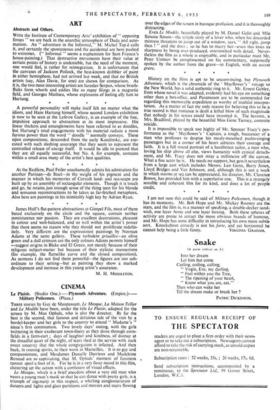ART
Abstracts and Others.
WITH the Institute of Contemporary Arts' exhibition of " opposing forces " we are back in the anarchic atmosphere of Dada and auto- matism. An " adventure in the Informal," M. Michel Tap.6 calls it, and certainly the spontaneous and the accidental are here pushed to extremes. (" Informal " seems a euphemism for Sam Francis's house-painting.) That destructive movements have their value at certain points of history is undeniable, but the need of the moment, one would feel, is rather for reintegration. It is unfortunate that the canvases of Jackson Pollock, the best-known dribbler of paint in either hemisphere, had not arrived last week, and that no British artists (say, Alan Davie, for one) are shown for comparison. As it is, the two most interesting artists are Iaroslav Serpan, whose brush- flicks form whorls and eddies like so many filings in a magnetic field, and Georges Mathieu, whose explosions of feeling ally hun to Hartung.
• • A powerful personality will make itself felt no matter what the idiom, and Hans Hartung himself, whose second London exhibition is now to be seen at the Lefevre Gallery, is an example of the free, impulsive approach to abstraction at its most impressive. His linear thickets and entanglements have been referred to as doodles, but Hartung's total engagements with his material radiate a more furious power than the word " doodle " normally conveys. These open compositions, descended from the early Kandinsky, are exe- cuted with such slashing assurance that they seem to represent the controlled release of energy itselr. It would be idle to pretend that they are all equally successful, but No. 4, for example, contains within a small area many of the artist's best qualities.
* * * *
At the Redfern, Paul Feiler unashamedly admits his admiration for another Parisian—de Stael—in the weight of his pigment and the manner in which his memories of Cornish land- and sea-scape are built up by an assembly of rectangular elements. Though it is touch and go, he retainsjust enough sense of the thing seen for his blonde and sensuous reconstructions to be taken as far-fetched metaphors. Also here are paintings in his inimitably high key by Adrian Ryan.
James Hull's flat-pattern abstractions at Gimpel Fils, most of them based exclusively on the circle and the square, contain neither reminiscence nor passion. They are excellent decorations, pleasant in colour and well-balanced, and so well within the artist's power that there seems no reason why they should not proliferate indefin- itely. Very different are the expressionist paintings by Norman Adams at the same gallery. These turbulent grisailles—an olive green and a dull crimson are the only colours Adams permits himself —suggest origins in Blake and El Greco, not merely because of their religious subject-matter but because of their stylistic mannerisms (for example, the flamelike curve and the closed composition). As sermons I do not find them powerful—the figures are too sub- ordinate to their setting—but as painting they show a marked development and increase in this young artist's assurance.
M. H. MIDDLETON.


































 Previous page
Previous page